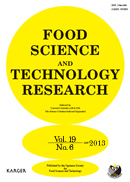Volume 19, Issue 6
Displaying 1-32 of 32 articles from this issue
- |<
- <
- 1
- >
- >|
Review
-
2013Volume 19Issue 6 Pages 923-932
Published: 2013
Released on J-STAGE: January 21, 2014
Download PDF (914K)
Food Technology and Engineering
Original papers
-
2013Volume 19Issue 6 Pages 933-938
Published: 2013
Released on J-STAGE: January 21, 2014
Download PDF (2899K) -
2013Volume 19Issue 6 Pages 939-947
Published: 2013
Released on J-STAGE: January 21, 2014
Download PDF (956K) -
2013Volume 19Issue 6 Pages 949-956
Published: 2013
Released on J-STAGE: January 21, 2014
Download PDF (689K) -
2013Volume 19Issue 6 Pages 957-962
Published: 2013
Released on J-STAGE: January 21, 2014
Download PDF (432K) -
2013Volume 19Issue 6 Pages 963-970
Published: 2013
Released on J-STAGE: January 21, 2014
Download PDF (419K)
Technical papaer
-
2013Volume 19Issue 6 Pages 971-978
Published: 2013
Released on J-STAGE: January 21, 2014
Download PDF (875K)
Notes
-
2013Volume 19Issue 6 Pages 979-982
Published: 2013
Released on J-STAGE: January 21, 2014
Download PDF (444K) -
2013Volume 19Issue 6 Pages 983-987
Published: 2013
Released on J-STAGE: January 21, 2014
Download PDF (452K) -
2013Volume 19Issue 6 Pages 989-993
Published: 2013
Released on J-STAGE: January 21, 2014
Download PDF (526K) -
2013Volume 19Issue 6 Pages 995-1001
Published: 2013
Released on J-STAGE: January 21, 2014
Download PDF (1341K)
Food Science and Chemistry
Original papers
-
2013Volume 19Issue 6 Pages 1003-1009
Published: 2013
Released on J-STAGE: January 21, 2014
Download PDF (911K) -
2013Volume 19Issue 6 Pages 1011-1018
Published: 2013
Released on J-STAGE: January 21, 2014
Download PDF (342K) -
2013Volume 19Issue 6 Pages 1019-1027
Published: 2013
Released on J-STAGE: January 21, 2014
Download PDF (741K) -
2013Volume 19Issue 6 Pages 1029-1035
Published: 2013
Released on J-STAGE: January 21, 2014
Download PDF (531K) -
2013Volume 19Issue 6 Pages 1037-1043
Published: 2013
Released on J-STAGE: January 21, 2014
Download PDF (252K) -
2013Volume 19Issue 6 Pages 1045-1050
Published: 2013
Released on J-STAGE: January 21, 2014
Download PDF (446K) -
2013Volume 19Issue 6 Pages 1051-1059
Published: 2013
Released on J-STAGE: January 21, 2014
Download PDF (773K) -
2013Volume 19Issue 6 Pages 1061-1069
Published: 2013
Released on J-STAGE: January 21, 2014
Download PDF (1455K) -
2013Volume 19Issue 6 Pages 1071-1075
Published: 2013
Released on J-STAGE: January 21, 2014
Download PDF (1155K) -
Rapid Classification of Citrus Fruits Based on Raman Spectroscopy and Pattern Recognition Techniques2013Volume 19Issue 6 Pages 1077-1084
Published: 2013
Released on J-STAGE: January 21, 2014
Download PDF (907K) -
2013Volume 19Issue 6 Pages 1085-1092
Published: 2013
Released on J-STAGE: January 21, 2014
Download PDF (2261K) -
2013Volume 19Issue 6 Pages 1093-1097
Published: 2013
Released on J-STAGE: January 21, 2014
Download PDF (337K)
Technical papers
-
Objective Evaluation of Astringent and Umami Taste Intensities of Matcha using a Taste Sensor System2013Volume 19Issue 6 Pages 1099-1105
Published: 2013
Released on J-STAGE: January 21, 2014
Download PDF (560K) -
2013Volume 19Issue 6 Pages 1107-1114
Published: 2013
Released on J-STAGE: January 21, 2014
Download PDF (269K)
Notes
-
2013Volume 19Issue 6 Pages 1115-1119
Published: 2013
Released on J-STAGE: January 21, 2014
Download PDF (558K) -
2013Volume 19Issue 6 Pages 1121-1126
Published: 2013
Released on J-STAGE: January 21, 2014
Download PDF (476K) -
2013Volume 19Issue 6 Pages 1127-1131
Published: 2013
Released on J-STAGE: January 21, 2014
Download PDF (606K) -
2013Volume 19Issue 6 Pages 1133-1140
Published: 2013
Released on J-STAGE: January 21, 2014
Download PDF (484K) -
2013Volume 19Issue 6 Pages 1141-1147
Published: 2013
Released on J-STAGE: January 21, 2014
Download PDF (908K) -
Effects of Collagen Peptide Ingestion on Blood Lipids in Rats Fed a High-Lipid and High-Sucrose Diet2013Volume 19Issue 6 Pages 1149-1153
Published: 2013
Released on J-STAGE: January 21, 2014
Download PDF (475K)
Short communication
-
2013Volume 19Issue 6 Pages 1155-1163
Published: 2013
Released on J-STAGE: January 21, 2014
Download PDF (1565K)
- |<
- <
- 1
- >
- >|
